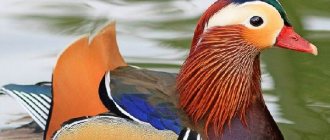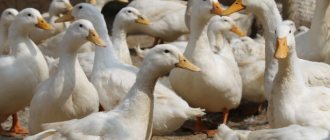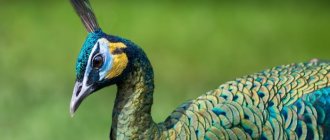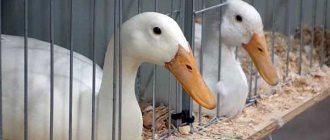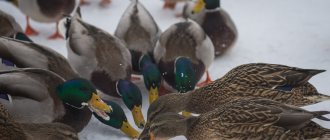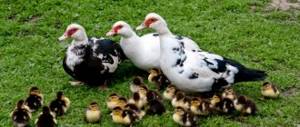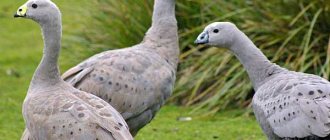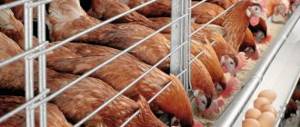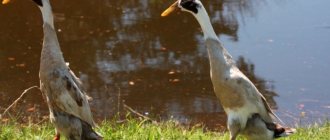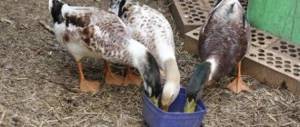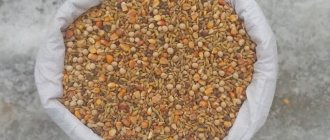Choosing a profitable breed for breeding
The breed of ducks is selected based on the purpose of breeding the bird - for meat, feathers, eggs. There are meat and egg varieties, but breeders have also developed egg-meat breeds. Experts advise beginners to start with the simplest species, which are unpretentious in maintenance and grow quickly.
Beijing
The breed is considered the most widespread in Russia. The name suggests that it was developed in China. Peking duck is a meat-egg duck - in 12 months, one mallard can produce up to 180-200 eggs. The weight of the female is 3.5 kg, the male is about 4 kg. Moreover, by 45 days of life the weight already reaches 2.5-3 kg.
Peculiarities:
- physique – powerful (wide back and chest, large head);
- forehead – convex;
- beak – bright orange;
- tail – small;
- down color – white or cream;
- paws – shortened;
- wingspan – wide;
- plumage density – high;
- character – restless, noisy;
- young meat – juicy, soft;
- adult meat is fatty;
- the weight of one egg is 80-90 g.
Peking ducks are distinguished by a high degree of hatching - per season, from 6 females hatch up to 120-150 chicks. The breed easily tolerates cool climates and does not overeat food.
There are also disadvantages - you need to completely eliminate high humidity, otherwise the individuals begin to get sick.
Bashkir color
The species was selected not so long ago - in the first years of our century. The meat of Bashkir colored ducks is considered dietary, since it does not contain fatty layers. Despite this, birds tolerate the cold well. The breed is raised for meat and eggs.
Characteristic:
- physique – strong, with muscles;
- beak – concave, beige;
- colors – females are discreet, males are brightly colored;
- body weight of females / males – 3.5 / 4 kg;
- egg production – 200-225 pieces per year;
- egg weight - about 90 g;
- paws are short;
- a small tail is raised up;
- medium sized head;
- the wings are large.
The breed has a strong, stable immune system and rarely gets sick. Among the disadvantages, duck breeders note poor incubation and the need for large amounts of food. But do not overfeed them - otherwise obesity will occur.
Indian
Another name is musky duck. She was brought to us from the southern part of America. Many people mistakenly believe that ducks and turkeys were used during selection, but this is not so. The main advantage of the breed is the breeding of offspring without human intervention. This is a meat variety with a very valuable liver.
Description:
- female body weight – from 1.8 to 3 kg, male – from 4 to 6 kg;
- large build (wild ducks are 2 times smaller);
- the behavior of males is aggressive, the presence of children should not be allowed nearby;
- meat – dietary lean;
- eggs weigh more than 110 g;
- Average egg production – 70-120 pieces;
- beak – beige or red;
- feather color is often black and white, but there are also multi-colored individuals;
- immunity is strong.
Indo-ducks are considered the best brood hens, but they cannot tolerate increased dampness, require a lot of space, and gain body weight slowly.
Mulard
The breed was obtained by crossing a Peking duck (female) and an Indo duck (drake). You can remove it yourself. Mulard has absorbed the best qualities of his parents - he grows quickly and becomes as large as possible. Refers to meat species.
Peculiarities:
- weight – from 4 to 7 kg, depending on age and sex (the difference between a male and a female is no more than 500-600 g);
- colors – varied;
- beak – light pink, yellow;
- there is always a dark spot on the head;
- character – balanced and calm;
- the neck is long, like that of a geese;
- body – elongated;
- paws – shortened but massive;
- egg weight - about 80-100 g;
- egg production - from 180 to 210 pieces.
Mulards do not like to hatch chicks, and their eggs are most often infertile. They are bred exclusively for meat and fluff. The liver of drakes is used to prepare foie gras.
Moscow white
The breed was developed by crossing a female Indoutka and a male Campbell. It is characterized by exclusively white color and juicy tender meat. Raised for feathers and meat.
Characteristic:
- female weight – 3.5 kg, drake – 4 kg;
- egg weight – 80-90 g;
- egg production - from 100 to 150 eggs per season;
- neck – long, powerful;
- physique – strong, muscular, wide;
- beak – large, red or pink;
- sternum – rounded;
- head – small;
- paws – short and widely spaced;
- blue eyes.
Moscow whites belong to the group of waterfowl. Set up a pond for them. They are calm in nature, but they like to run away and eat too much.
Black white breasted
It is considered popular among duck breeders, as it quickly gains weight and has a high percentage of egg fertility (90% hatch chicks). It was selected from 3 varieties - Peking, Khaki Campbell and Ukrainian White-breasted.
Indicators:
- female body weight – 3.5 kg, drake – 4 kg;
- egg weight – 80-100 g;
- egg production - up to 130 eggs per year;
- color – white-black;
- body – long and wide;
- sternum – concave;
- head – small;
- neck – elongated, flexible;
- beak – black and short, slightly curved down;
- eyes – black;
- There is a greenish tint on the neck of males.
The main disadvantage is the need to create an artificial pond, since Black White-breasted Ducks cannot do without swimming. Raised for meat, fluff and eggs.
Gray Ukrainian
This is a breed with a developed muscular system, an elongated body, a wide back and chest. Feature: there are no wedge-shaped processes on the abdomen. Used to produce fluff and meat. There are 2 types of color - white and wild feathered (chocolate or golden plumage).
Peculiarities:
- beak – yellow-orange or olive;
- paws – red, orange or gray;
- the shimmer on the back and sides is blue, gray, shiny;
- meat – soft, tender;
- male body weight – 3.8-4 kg, female – up to 3 kg;
- egg weight – from 70 to 90 g;
- egg production - maximum 140 eggs per year.
Like the previous breed, it cannot survive without water. Ducks are considered poor brood hens; it is advisable to breed them using the incubator method. The slightest drafts and crowding of birds should not be allowed.
Keeping pets with a pond
It is worth looking at the table of contents of any book on poultry farming, and it becomes clear that walking is an important part of bird care.
A walk with a pond is an ideal solution for keeping ducks in the country. In addition to walking on the water, ducks will be able to feast on small crustaceans, fish and duckweed.
With this method of keeping and breeding ducks, it is not necessary to make a canopy, since the bird cools well on the water. With such grazing, the cost of keeping birds is reduced by 5 times. The owner only needs to send the ducks out to the water in the morning and simply bring them back at the end of the day, which means he can worry much less about how to care for the birds.
However, several requirements for the pond must be met:
- it should not be heavily overgrown or swampy;
- trees are needed near the shore for shade;
- fence part of the bird pond with a net - 0.5 m in height and 70 cm deep into the water;
- If there is no pond, an artificial reservoir can be built.
How to choose a pair?
To create a family, individuals with excellent health are selected - birds with obesity and underweight should not be mated. There should be from 5 to 7 females per drake. Other features:
- the herd must contain individuals of the same breed and age;
- You cannot mate ordinary species with hybrid ones;
- a single set consists of individuals that hatched from July to August;
- multiple picking - take birds that were born from January to May or in September.
Females and drakes should have the same character and “like” each other. Otherwise, mating will not occur.
Free grazing without a pond
Keeping ducks without a pond is quite possible. To do this, they fence off the area, constructing canopies for young birds and ducklings. The height of the fence should not be less than one meter.
Free, unlimited access to water for ducks on dry range is required. If there is no shade in the walking area, build a shelter from the sun and precipitation.
Birds are fed four times a day during the walk. Dishes with shells, fine gravel and water for washing beaks are also placed in the fenced area.
When does mating season begin?
Mallard ducks are selected for mating 150 days after hatching. The optimal time is considered to be 8-12 months of age, due to which the offspring will be healthy and full-fledged. The beginning of the mating season can be determined by the following signs:
- The male's plumage changes - it becomes brighter and more expressive.
- The drake performs the ritual, accompanying it with sound signals (this is whistling, hissing, quacking). In some cases, the female does the same.
- Females begin to raise their tails.
- The nest is being prepared - the ducks carefully build it from branches, straw and other materials.
Ducks mate both on land and in water. They do not have special openings; biological fluids are exchanged through cloacas. To do this, the male presses tightly against his partner and transfers seminal fluid. From her cloaca it penetrates to the eggs.
Methods of raising chickens
One clutch consists of 7-12 eggs. It takes 28 days to incubate, after which the chicks hatch, and after 10-12 hours they are ready to run and swim. If a duck does not sit on eggs, it is easy to place them under a chicken or other bird, but you cannot place eggs from other animals under a duck - it will not accept them.
Raising chickens with a hen
This is a natural way to produce duck chicks. This type of breeding is used when there are breeds of females that are capable of hatching eggs. It is permissible to lay a certain number of eggs under one individual:
- in summer - 12-15 pieces;
- in spring – 10-12.
If a turkey or chicken is used as a brood hen, the quantity varies - it depends on the size of the bird.
Follow the rules and features:
- arrange the eggs evenly so that each one receives enough heat;
- form a nest of straw and feathers (the shape should resemble a wreath);
- if the perch is located on the floor, be sure to lay insulating material under it (especially if the flooring is concrete) - sawdust, chaff (waste from cereals);
- the location of the nest is a dark area of the duck bed;
- to create maximum comfort for females, separate perches with partitions;
- immediately after hatching, separate the ducklings from the female - there is a risk that she will crush them;
- transfer the young animals to a cardboard box with straw.
Growing in an incubator
If you breed ducks using the incubator method, you can get offspring at absolutely any time of the year. For this purpose, special incubators are used, equipped with temperature and humidity regulators.
Be sure to consider the following nuances:
- Selection of eggs. Place only fertilized eggs and those that are not damaged (cracks, chips) in the incubator. To do this, do this:
- Check the location of the air chamber - it should be at the bottom, not at the top.
- Inspect the yolk - its position should be in the center and slightly offset towards the air chamber.
- Check the integrity of the yolk - spin the egg, and if the yolk moves, it is not fertilized.
- Incubator hatching technology. Before placing eggs in the equipment, warm it up to 38.4°C. Be sure to place containers of water on the tray, as the humidity level should be 55-60%. Next, proceed as follows:
- Place the eggs and set the temperature to 38.2°C. Keep it like this for 3 days.
- On day 4, set the thermometer to 37.8°C.
- On the 14th day, reduce the readings further – to 32°C.
- From this day on, open the incubator twice a day for ventilation (for 25-30 minutes).
- Ovoscoping. The procedure is carried out 2 times over the entire 28 days. It involves examining eggs for suitability for hatching chicks:
- On day 7, the circulatory system of the embryo is examined. If it is not there, the egg is considered unfertilized.
- On the 26th day, the movement of the chick is observed (when the embryo freezes, a dark stationary spot is visible).
- Hatching dates. The first chick appears on the 27th day, and by the end of the 28th all the chicks should hatch. Since the shell of duck eggs is strong, sometimes you have to help - remove the shell from the peck site.
Raising ducks at home: maintenance and care
Ducks are waterfowl, so in the summer they need some kind of container with water or a pond in which they can swim. If there is a pond or lake nearby, then the problem is solved - the bird will receive not only the conditions necessary for proper development, but also the necessary microelements that are found in natural reservoirs.
In a private backyard, it’s easy to build a small pond yourself by digging a hole in the ground and filling it with concrete. If there is some kind of container, then it can be dug into the ground to such a level that the bird can easily access water. You can make a pool for ducks from old car tires. It is advisable to find a tire from a truck or tractor, cut it lengthwise into two parts and fill it with water. This will create two containers of water.
Breeding ducklings
For productive breeding of ducklings, create favorable conditions and strictly follow all requirements. The basis for success is the rules of feeding and maintenance, especially until the age of one month, when the chicks need careful care.
The necessary conditions
The main conditions for breeding ducklings are temperature, lighting and walking:
- Temperature conditions. If the chicks are kept by a hen, there is no point in monitoring the temperature in the room, since they hide under her wing to keep warm. In other cases, adhere to these rules:
- in the first 7 days, set the thermometer to 27-30°C;
- from 8 to 14 days – from 23 to 26°C;
- from 15 to 30 days – from 19 to 22°C.
Feeding
Pay special attention to feeding - the level of further egg production, the rate of meat growth, and the health of the bird depend on it. From birth, accustom them to a routine - give food at the same time. Thanks to this, by 1.5-2 months of life the bird will have exactly half its weight.
Rules for feeding ducklings in the first days:
- Up to 8 days, the daily food ration is divided into 7-8 meals - boiled eggs, cottage cheese, kefir.
- In the next 7 days, include greens and specialized food in an amount of 40 g.
- From the 15th day, fermented milk products and eggs are excluded, but mostly feed on grass and grass (optimally duckweed).
- From 30 days, transfer the ducklings to regular food.
Never place feeders next to drinking bowls, as young animals begin to wash down their food with water, contaminating it, which increases the risk of infection during this period of life. The drinking bowls should be small so that the chicks cannot get their paws into them (they perceive the water as a swimming pool).
Be sure to add potassium permanganate to the water - the solution should have a light pink tint.
Care
If the ducklings hatched in an incubator, transfer them to a cardboard box. Place straw at the bottom in a layer of up to 2-3 cm. If a hen was sitting on the eggs, after all the chicks hatch, return them to the duck. Don't forget to check if the female has accepted all the chicks.
What to do next:
- Keep the box or room dry - change the litter 2-3 times a day (to simplify the cleaning process, place newspaper or paper under the straw);
- After each meal, remove leftovers;
- when you give them baths for bathing, make sure the water is clean, which should be at room temperature (otherwise the ducklings will catch a cold);
- close all cracks to eliminate drafts in the first 2 weeks of life;
- if it’s warm outside, take them outside three times a day (for 30-60 minutes, gradually increasing the walking time).
Requirements for the place where young animals are kept
The little duckling, which arrived in a new place just a day after birth, has not yet acquired an immunity strong enough to survive. Cleanliness of the room is a critical point if ducklings are planned to be kept.
A week before the arrival of the ducklings, it is necessary to carry out disinfection by whitewashing the walls with lime and destroying all possible parasites. Try to get rid of houseflies, cockroaches, wasps and ants. The presence of cats and dogs in bird nurseries is undesirable. Also read the article “Building a brooder for ducklings with your own hands.”
Basic requirements for a standard poultry house:
- the floor is located 30 cm above the ground, made of concrete, not wood;
- walls are made up to 1.8 m high, but not less than 1 m;
- humidity level is 65-70%, no drafts.
- daylight hours should last at least 14 hours, this can be achieved with artificial lighting;
- Make a hole from the poultry house measuring 40 by 40 cm with a vestibule to prevent precipitation and drafts from entering.
Read more in the article “Building a house for a duckling: building a pen with your own hands.”
Arriving day-old babies are placed in the poultry house at the rate of 20 birds per square meter. The walking area should be 2.5 square meters for the same amount.
Common mistakes and useful tips
To avoid making mistakes that are typical for beginners when breeding ducks, experienced duck breeders give useful recommendations. Be sure to take them into account when raising this type of poultry:
- Ducks lay eggs in the morning. Don't let them out onto the pond or out of their pen until 9-10 am.
- Water procedures should not exceed 5 hours in a row. Birds need to eat actively
- Do not leave food in feeders overnight - birds will become obese.
- Feed with concentrated feed in the morning, greens in the afternoon, and vegetables and root vegetables in the evening.
- If a farmer starts a parent herd for breeding, allocate no more than 5 females for 1 drake;
- Select the largest and healthiest individuals for breeding offspring, do not keep them for more than 2 years.
- For meat, slaughter ducks no older than 2.5 months, since then molting begins, and with it weight loss.
- 2-3 weeks before slaughter, feed the birds intensively.
- To prevent ducks from stopping laying eggs, do not move them from one barn to another, do not change their usual daily routine.
- To protect the bird, disinfect the area.
With a competent approach to duck breeding, you can achieve amazing success in 1 year - increase the number of ducks by 10 times, while constantly consuming meat and eggs, and using down for featherbeds and pillows. Choose your breed carefully so that you don’t have any problems with hatching eggs at first.
0
0
Copy link
Poultry slaughter
If you are breeding ducks, then sooner or later you will have to slaughter some of your pets for meat. There are two slaughter methods:
- Chopping off the head. This method of killing a bird is simple and reliable: you need to place the duck on a flat surface, press its head and, with a sharp movement of a wide knife, cut it off from the neck. Then the bird should be immobilized, hung by the legs and wait until the carcass bleeds;
- Piercing the head through the beak. The bird is placed in a suspended bucket, the bottom of which is equipped with a small diameter hole. The duck's head is passed through this hole, firmly fixed with the hand, and a sharp object (an awl or a narrow knife) is inserted into the bird's mouth. Then they make a sharp movement towards the brain, killing the bird. The slaughtered duck is left in a bucket until the carcass is completely bled.
The note! Before slaughter, ducks are not fed for 12–18 hours, but they are provided with a large supply of water. This will help clean out the bird's intestines and ensure that the carcass is cut up quickly and easily.
Video - Slaughtering a duck
So, duck breeding is a fun and easy activity. Only the equipment of the poultry house and space for walking will require serious material costs, after which the business will begin to generate good income. Selling duck meat can be a good family business.
Video - Subtleties of breeding Muscovy ducks
Video - Breeding and keeping ducks in winter
Similar articles
- How to properly breed Indian ducks at home - detailed information!
This poultry has many names: mute duck, musky duck, tree duck, barbary duck, but the most accurate, if we keep in mind the appearance, is the name... - Mulard ducks: breeding at home - detailed information!
Mulards are a breed of duck that many new farmers are interested in. These pet birds have many features and advantages. Mulard ducks You can’t... - Breeding pheasants at home in detail + video and photos!
Tell me what associations you have when you mention the word “pheasant”. I think I won’t be too mistaken if I say that it will be some kind of feast or...
